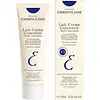What's inside
What's inside
 Key Ingredients
Key Ingredients

No key ingredients
 Benefits
Benefits

 Concerns
Concerns

 Ingredients Side-by-side
Ingredients Side-by-side

Water
Skin ConditioningCoco-Caprylate/Caprate
EmollientSqualane
EmollientGlycerin
HumectantCaprylic/Capric Triglyceride
MaskingPentylene Glycol
Skin ConditioningGlyceryl Stearate
EmollientMicrocrystalline Cellulose
AbsorbentCarbomer
Emulsion StabilisingSodium Stearoyl Glutamate
CleansingParfum
MaskingCaprylyl Glycol
EmollientCurcuma Longa Root Extract
MaskingSodium Benzoate
MaskingSodium Phytate
Xanthan Gum
EmulsifyingSodium Hydroxide
BufferingCitric Acid
BufferingHelianthus Annuus Seed Oil
EmollientTocopherol
AntioxidantPolylysine
Water, Coco-Caprylate/Caprate, Squalane, Glycerin, Caprylic/Capric Triglyceride, Pentylene Glycol, Glyceryl Stearate, Microcrystalline Cellulose, Carbomer, Sodium Stearoyl Glutamate, Parfum, Caprylyl Glycol, Curcuma Longa Root Extract, Sodium Benzoate, Sodium Phytate, Xanthan Gum, Sodium Hydroxide, Citric Acid, Helianthus Annuus Seed Oil, Tocopherol, Polylysine
Water
Skin ConditioningParaffinum Liquidum
EmollientStearic Acid
CleansingPalmitic Acid
EmollientGlyceryl Stearate Se
EmulsifyingTriethanolamine
BufferingCera Alba
EmollientCetyl Palmitate
EmollientButyrospermum Parkii Butter
Skin Conditioning1,2-Hexanediol
Skin ConditioningCaprylyl Glycol
EmollientSteareth-10
EmulsifyingPolyacrylamide
C13-14 Isoparaffin
EmollientParfum
MaskingLaureth-7
EmulsifyingPropylene Glycol
HumectantTropolone
Skin ConditioningHydrolyzed Soy Protein
HumectantAloe Barbadensis Leaf Extract
EmollientWater, Paraffinum Liquidum, Stearic Acid, Palmitic Acid, Glyceryl Stearate Se, Triethanolamine, Cera Alba, Cetyl Palmitate, Butyrospermum Parkii Butter, 1,2-Hexanediol, Caprylyl Glycol, Steareth-10, Polyacrylamide, C13-14 Isoparaffin, Parfum, Laureth-7, Propylene Glycol, Tropolone, Hydrolyzed Soy Protein, Aloe Barbadensis Leaf Extract
 Reviews
Reviews

Ingredients Explained
These ingredients are found in both products.
Ingredients higher up in an ingredient list are typically present in a larger amount.
Caprylyl Glycol is a humectant and emollient, meaning it attracts and preserves moisture.
It is a common ingredient in many products, especially those designed to hydrate skin. The primary benefits are retaining moisture, skin softening, and promoting a healthy skin barrier.
Though Caprylyl Glycol is an alcohol derived from fatty acids, it is not the kind that can dry out skin.
This ingredient is also used as a preservative to extend the life of products. It has slight antimicrobial properties.
Learn more about Caprylyl GlycolParfum is a catch-all term for an ingredient or more that is used to give a scent to products.
Also called "fragrance", this ingredient can be a blend of hundreds of chemicals or plant oils. This means every product with "fragrance" or "parfum" in the ingredients list is a different mixture.
For instance, Habanolide is a proprietary trade name for a specific aroma chemical. When used as a fragrance ingredient in cosmetics, most aroma chemicals fall under the broad labeling category of “FRAGRANCE” or “PARFUM” according to EU and US regulations.
The term 'parfum' or 'fragrance' is not regulated in many countries. In many cases, it is up to the brand to define this term.
For instance, many brands choose to label themselves as "fragrance-free" because they are not using synthetic fragrances. However, their products may still contain ingredients such as essential oils that are considered a fragrance by INCI standards.
One example is Calendula flower extract. Calendula is an essential oil that still imparts a scent or 'fragrance'.
Depending on the blend, the ingredients in the mixture can cause allergies and sensitivities on the skin. Some ingredients that are known EU allergens include linalool and citronellol.
Parfum can also be used to mask or cover an unpleasant scent.
The bottom line is: not all fragrances/parfum/ingredients are created equally. If you are worried about fragrances, we recommend taking a closer look at an ingredient. And of course, we always recommend speaking with a professional.
Learn more about ParfumWater. It's the most common cosmetic ingredient of all. You'll usually see it at the top of ingredient lists, meaning that it makes up the largest part of the product.
So why is it so popular? Water most often acts as a solvent - this means that it helps dissolve other ingredients into the formulation.
You'll also recognize water as that liquid we all need to stay alive. If you see this, drink a glass of water. Stay hydrated!
Learn more about Water